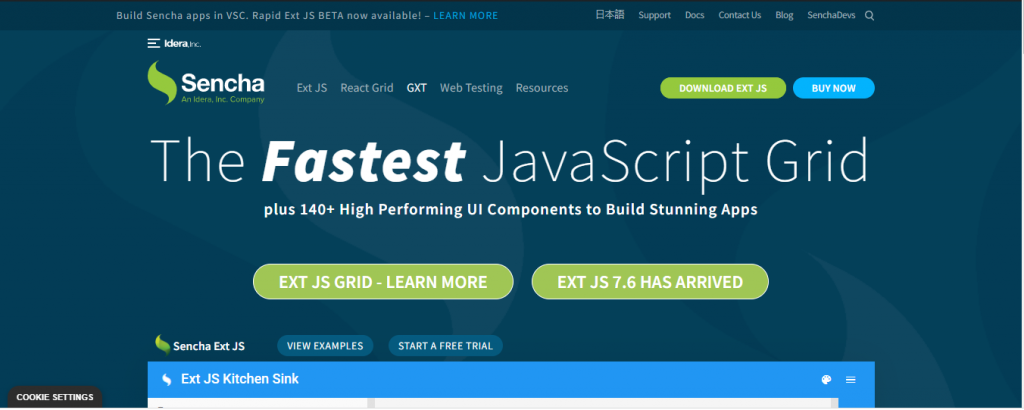7 Best Practices for Front-End Web Apps Development With Ext JS
In today’s digital landscape, front-end web app development has become essential to creating rich and interactive user experiences. Moreover, developers often seek reliable solutions with the multitude of frameworks available. One of the popular front end frameworks that has gained significant traction is Ext JS. Ext JS is a feature-rich JavaScript framework that empowers developers to build dynamic and responsive web applications.
Ext JS possesses an extensive set of components, advanced data binding, and powerful MVC architecture. Hence, making it a top choice for front-end web app development. However, it is crucial to follow best practices to harness the full potential of Ext JS and ensure efficient and effective development.
Implementing these best practices offers several benefits. Firstly, it promotes code consistency. Hence, making it easier for developers to collaborate and maintain codebases over time. Secondly, it enhances performance, resulting in faster web app load and smoother user interactions.
Additionally, best practices ensure better accessibility, cross-browser compatibility, and improved security. Hence, providing a seamless experience across various devices and platforms. In this blog, we will explore seven essential best practices for front-end web app development with Ext JS. Let’s begin.
What Are the Key Features and Advantages of the Ext JS Framework?
Ext JS is a powerful and comprehensive JavaScript framework. Besides, it offers a range of key features and advantages for front-end web app development. Hence, making it a preferred choice among developers. Let’s delve into some of these features and explore how they simplify front-end development and enhance the user experience.
1. Rich Component Library
Ext JS provides an extensive library of pre-built, customizable UI components, such as grids, forms, charts, and menus. Ultimately, this vast collection allows developers to quickly assemble complex interfaces with minimal coding. Hence, saving time and effort.
2. MVC Architecture
The Model-View-Controller (MVC) architecture employed by Ext JS promotes a structured approach to development. Furthermore, separating concerns and improving code organization. Besides, it enables developers to separate data, presentation, and application logic. Hence, facilitating easier collaboration and code maintenance.
3. Data Binding and Grids
Ext JS offers powerful data binding capabilities. Hence, allowing developers to establish seamless connections between data models and UI components. Moreover, this feature simplifies data manipulation and synchronization. Hence, providing real-time updates and enhancing the overall user experience.
4. Cross-Browser Compatibility
Ext JS ensures consistent performance across various web browsers. Hence, eliminating the need for extensive browser-specific tweaks. Moreover, this compatibility significantly reduces development time and ensures a uniform user experience on different platforms.
5. Theming and Customization
With Ext JS, developers can easily customize their applications’ look and feel through themes. Moreover, the framework provides a theming infrastructure that enables developers to modify visual styles.
6. Responsive Design
Ext JS supports responsive web design principles. As a result, enabling developers to create applications that adapt to different screen sizes and resolutions. Furthermore, this flexibility ensures a consistent user experience across desktops, tablets, and mobile devices.
7. Scalability and Performance
Ext JS is designed to handle large-scale applications with ease. Moreover, the optimized rendering engine and efficient data handling capabilities ensure smooth performance.

How to Set up the Ext JS Development Environment?
This section provides instructions for downloading and setting up Ext JS on your computer. Please follow the steps below to configure the environment.
1. Downloading Library Files
Obtain the trial version of Ext JS library files by visiting Sencha’s website at https://www.sencha.com. Then, the trial version will be sent to your registered email address as a compressed folder named ext-6.0.1-trial.
If you’re ready to get started, click here to download the free trial.
2. Extracting the Folder
Unzip the folder to reveal various JavaScript and CSS files you must include in your application. Then, we will mainly utilize the essential files in the following directory: \ext-6.0.1-trial\ext6.0.1\build.
- Ext.js
This file is the main component containing all the functionalities required to run the application.
- Ext-all.js
Within this file, you will find all the code compacted without any comments.
- Ext-all-debug.js
For debugging purposes, this version of ext-all.js is available without code modification. Hence, allowing for easier troubleshooting.
- Ext-all-dev.js
Similarly, this file is specifically designed for development purposes. Hence, including comments and console logs to assist in identifying errors or issues.
- Ext-all.js
Primarily used in production environments, this file is optimized for size. Hence, making it smaller than other options.
CSS Files
There are multiple theme-based files available. Moreover, these can be located in the following directory: \ext6.0.1-trial\ext-6.0.1\build\classic\theme-classic\resources\theme-classic-all.css.
You can utilize the classic themes to develop a desktop application. Then, you can find them in the folder: \ext-6.0.1-trial\ext-6.0.1\build\classic
Additionally, you can utilize the modern themes in the folder for mobile applications: \ext-6.0.1-trial\ext-6.0.1\build\modern.
The Ext JS application will require the inclusion of the following library files.
| <html> <head> <link rel = “stylesheet” type = “text/css” href = “..\ext-6.0.1-trial\ext-6.0.1\build\classic\theme-classic\resources\theme-classic-all.css” /> <script type = “text/javascript” src = “..\ext-6.0.1-trial\ext-6.0.1\build\ext-all.js” > </script> <script type = “text/javascript” src = “app.js” > </script> </head> </html> |
You must keep the above code inside the app.js file.

CDN Setup
A content delivery network (CDN) eliminates the need for downloading Ext JS library files. Instead, you can directly incorporate the CDN link for ExtJS into your program, as shown below:
| <html> <head> <link rel = “stylesheet” type = “text/css” href = “https://cdnjs.cloudflare.com/ajax/libs/extjs/6.0.0/classic/theme-crisp/resources/theme-crisp-all.css” / > <script type = “text/javascript” src = “https://cdnjs.cloudflare.com/ajax/libs/extjs/6.0.0/ext-all.js”> </script> <script type = “text/javascript” src = “app.js” > </script> </head> </html> |
Popular Editors
Using the Ext JS JavaScript framework, our project will involve HTML and JS files for web application development. Moreover, a text editor is required to write Ext JS programs. Options for this include Notepad, Notepad++, and Sublime (recommended for this tutorial). Another option is Eclipse, an IDE available for download from https://www.eclipse.org/.
Browser
Ext JS ensures cross-browser compatibility and works seamlessly on various major browsers, including:
– Internet Explorer (version 6 and above)
– Firefox (version 3.6 and above)
– Chrome (version 10 and above)
– Safari (version 4 and above)
– Opera (version 11 and above)
You can choose any of these browsers to run your Ext JS application.
Also Read: Top Low-Code Platforms for Rapid Web App Development
What Is the Importance of Designing an Intuitive and Visually Appealing User Interface?
Designing an intuitive and visually appealing user interface (UI) is important in software development. Moreover, this UI enhances the user experience by providing a seamless and intuitive navigation flow. Besides, incorporating responsive design principles and accessibility ensures that the UI adapts to different devices. Moreover, it is usable by people with disabilities.
How to Implement Ext JS Data Models and Stores?
The data package is responsible for loading and saving data within the application. Furthermore, it consists of several classes, the most vital ones being the Model, Store, and Proxy classes.
Model
The Ext.data.Model class helps us define entities in an application. Moreover, it facilitates the binding of store data to the view and establishes a mapping between backend data objects and the view’s dataIndex. Besides, the data is retrieved through the use of a store.
Additionally, we extend the Ext.data.Model class to create a model and define the fields with their names and mappings. For example:
| “` Ext.define(‘StudentDataModel’, { extend: ‘Ext.data.Model’, fields: [ {name: ‘name’, mapping: ‘name’}, {name: ‘age’, mapping: ‘age’}, {name: ‘marks’, mapping: ‘marks’} ] }); “` |
In this code snippet, the names should match the dataIndex declared in the view. Moreover, the mapping should correspond to the data fetched from the database, whether static or dynamic, using the store.
Stores
The Ext.data.Store class is the foundation for managing locally cached data rendered in the view using model objects. Moreover, the store retrieves data using proxies, which define the service paths for fetching backend data.
Ultimately, there are two ways to fetch store data: static and dynamic.
Static Store
In a static store, all the data is present within the store itself, as shown in the following code:
| “`javascript Ext.create(‘Ext.data.Store’, { model: ‘StudentDataModel’, data: [ { name: “Rahul”, age: “16”, marks: “90” }, { name: “Akshay”, age: “18”, marks: “95” }, { name: “Nandni”, age: “20”, marks: “68” }, { name: “Akbar”, age: “21”, marks: “86” }, { name: “Shaila”, age: “22”, marks: “57” } ] }); “` |
Dynamic Store
Dynamic data can be fetched using a proxy. Moreover, the proxy can retrieve data via Ajax, Rest, or JSON methods.

How To Manage Application State and URL Routing In Ext JS Applications?
Managing application state and URL routing is crucial for a seamless user experience. Moreover, it enables preserving and synchronizing the application’s state across different views. Hence, it allows users to bookmark or share specific application states through URLs. Let’s check out the routing mechanism in Ext JS.
The Router in Ext JS is responsible for decoding URLs and executing controller functions. Moreover, routes are defined within a Controller. Hence, specifying the URL pattern and corresponding controller function.
The Router relies on the Ext.util.History singleton to detect changes in the browser’s URL. Additionally, it is recommended that developers define routes within Controllers rather than interacting directly with the Router.
What Are the Techniques for Optimizing the Performance and Responsiveness of Ext JS Apps?
To optimize the performance and responsiveness of your Ext JS applications, consider the following techniques:
- Opt for a high-performing native app.
Focus on building applications that perform well natively. Hence, ensuring a smooth user experience across different devices.
- Select the right server and utilize caching.
Choose a server that can handle the application’s demands efficiently. Moreover, implement caching techniques to store frequently accessed data and reduce server requests.
- Utilize a Content Delivery Network (CDN)
Employ a CDN to distribute your application’s static resources, such as JavaScript files and images, across multiple servers. Hence, enhancing their delivery speed and performance.
- Optimize images and content.
Compress and optimize images to reduce file sizes without compromising visual quality. Additionally, optimize your application’s content to improve loading times.
- Minimize ads and analytics.
Reduce the number of ads and analytics scripts in your application, as they can negatively impact performance. Moreover, only include those that are essential for your app’s functionality.
- Familiarize yourself with helpful tools.
Explore and utilize performance monitoring and profiling tools to identify performance bottlenecks. Then, optimize your application accordingly.
- Encourage users to install updates.
Regularly release updates to your application. Moreover, you must address performance issues and incorporate optimizations. Besides, prompt users to install these updates to benefit from improved performance and responsiveness.
How To Perform Thorough Testing and Debugging in Ext JS Development?
Thorough testing and debugging are crucial in Ext JS development to ensure your application’s reliability, functionality, and quality.
Testing helps identify and fix bugs and ensures proper functionality across different browsers and devices. Hence, it improves user experience.
Various testing approaches like unit, integration, and end-to-end testing are possible using frameworks like Jasmine, Sencha Test, or Selenium.
Front End Frameworks: Sencha Test
Sencha Test is a comprehensive testing tool. Furthermore, it is designed specifically for Ext JS development. Besides, it offers support for both unit testing and end-to-end testing. Hence, allowing you to test applications built with ExtAngular, Angular, ExtReact, and React. Furthermore, you can ensure the delivery of high-quality applications while reducing testing time and costs.
Additionally, Sencha enables the creation of end-to-end tests efficiently and allows simultaneous execution on multiple browsers. Moreover, it streamlines the testing process. Hence, helping you maintain the reliability and functionality of your applications.
How to Deploy and Maintain Ext JS Apps?
Let’s divide this section into four main parts to understand everything clearly.
Front End Frameworks: Deploying Ext JS Apps
When deploying Ext JS applications and making them available to users, it’s important to follow these best practices for a seamless deployment:
- a) Code Optimization
- Minify and compress JavaScript and CSS files to reduce size and improve performance.
- b) Efficient Loading
- Optimize loading by only loading necessary components and resources.
- Implement techniques like lazy loading and dynamic resource loading.
- c) Server Configuration
- Configure the webserver to cache static files and set appropriate HTTP headers.
- Enable GZIP compression for enhanced performance.
- d) Build Automation
- Use build tools like Sencha Cmd to automate processes such as code minification, file concatenation, and generating deployment-ready artifacts.
Front End Frameworks: Version Control & Documentation
It is essential to implement effective version control and code documentation practices. Here are some recommended approaches:
- a) Version Control with Git
- Utilize Git as your version control system and adopt a suitable branching strategy.
- Moreover, you should also maintain separate branches for development, staging, and production for a controlled release process.
- b) Clear Commit Messages
- Write informative commit messages that clearly explain the changes made in each commit.
- This enables easier tracking of changes. Hence, providing a historical context for the project.
- c) Comprehensive Code Documentation
- Document your code using relevant comments and inline documentation.
- This promotes future maintenance. Moreover, it also aids other developers in understanding and contributing to the project.
- d) API Documentation
- Generate API documentation for your Ext JS application using tools like JSDuck.
- This documentation serves as a reference for developers. Hence, ensuring code consistency.
Front End Frameworks: Release Management
To ensure a smooth deployment process and reduce the risk of bugs, follow these best practices:
- a) Release Planning
Set clear goals, prioritize features and estimate task effort. Moreover, you should also create a schedule and inform stakeholders.
- b) Continuous Integration
Integrate code frequently using tools like Jenkins or Travis CI. Hence, it detects issues early and maintains a releasable state.
- c) Testing and QA
Use automated testing (unit, integration, end-to-end) to verify Ext JS application functionality and stability. Then, apply quality assurance processes for issue identification and resolution prior to deployment.
- d) Rollback and Recovery
Prepare a rollback plan and regularly backup data. Moreover, you should also establish recovery mechanisms for unexpected deployment failures or issues.
Front End Frameworks: Regular Maintenance & Updates
Consider the following recommended practices:
- a) Security Patching
- Stay informed about security vulnerabilities and promptly apply patches.
- Additionally, you must update application dependencies to maintain a secure environment.
- b) Performance Monitoring
- Regularly monitor application performance, identify areas of improvement, and optimize critical sections. Hence, it can help to enhance the user experience.
- c) Compatibility Updates
- Keep track of new Ext JS releases and dependencies.
- Additionally, you must regularly assess and update your application to ensure compatibility with the latest browsers, operating systems, and devices.
- d) Bug Fixes and Enhancements
- Address reported bugs in a timely manner and prioritize enhancements based on user feedback.
- Furthermore, implement an issue-tracking system to efficiently manage bug fixes and feature requests.

Front End Frameworks: Conclusion
Mastering the best front-end web app development practices with Ext JS can significantly enhance quality. Moreover, you can ensure a smooth and efficient development process. Firstly, modularize your codebase to promote reusability and maintainability. Secondly, adopt a responsive design approach to provide seamless user experiences across different devices.
Thirdly, utilize Ext JS components effectively to leverage the framework’s extensive capabilities. Furthermore, adhere to coding standards and conventions to improve readability and collaboration. Besides, implement thorough testing to identify and fix potential issues early on. Moreover, optimize performance by optimizing loading times and minimizing resource usage. Finally, stay updated with Ext JS updates and embrace new features and improvements.
Front End Frameworks: FAQs
How Can I Get Started With Front-End Web App Development Using Ext JS?
Familiarize yourself with JavaScript, learn the Ext JS framework, and practice building interactive interfaces.
What Are the Key Benefits of Using Ext JS for Front-End Development?
Ext JS offers rich UI components, robust data handling, and seamless cross-browser compatibility. Moreover, it also offers extensive documentation.
How Do I Set up a Development Environment for Ext JS?
To set up a development environment for Ext JS, install Node.js & Sencha Cmd. Moreover, use a code editor like Visual Studio Code.
What Are the Best Practices for Designing an Intuitive User Interface in Ext JS?
- First, Keep the interface simple and clean.
- Second, Use consistent and familiar design patterns.
- Third, Prioritize user-centred design and usability testing.
- Fourth, Provide clear and intuitive navigation.
- Finally, Optimize responsiveness for different devices.
Experience the Power of Ext JS and Build Stunning Web Applications Today!

By 2026, Gartner says 80% of apps will be built using low code tools. That’s…

Did you know that nearly 90% of startups fail? And one of the biggest reasons…

The Sencha team is excited to announce the latest Sencha Rapid Ext JS 1.1.1 release…









